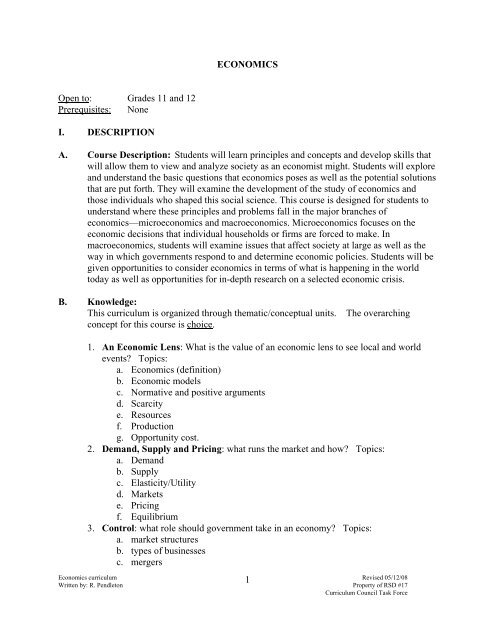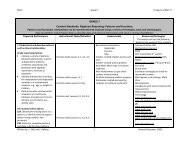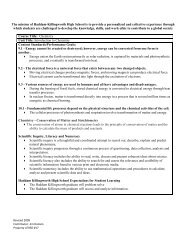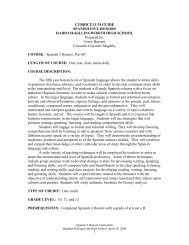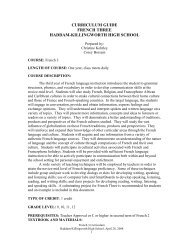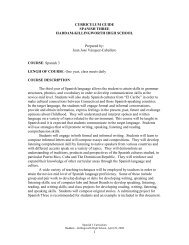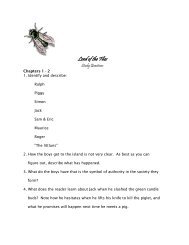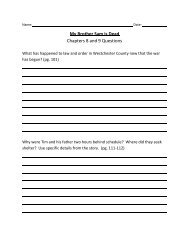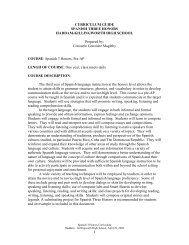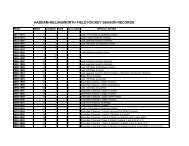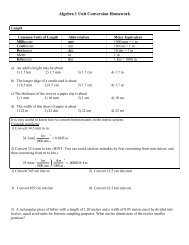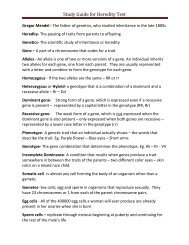ECONOMICS Open to: Grades 11 and 12 Prerequisites: None I ...
ECONOMICS Open to: Grades 11 and 12 Prerequisites: None I ...
ECONOMICS Open to: Grades 11 and 12 Prerequisites: None I ...
- No tags were found...
You also want an ePaper? Increase the reach of your titles
YUMPU automatically turns print PDFs into web optimized ePapers that Google loves.
d. conglomeratese. multi-nationalsf. externalitiesg. Anti-trust legislation <strong>and</strong> regulation.4. Work: Will unions be effective <strong>to</strong>ols for change in the future? Topics:a. Laborb. Unions5. Society: Are taxes fair? Is government spending done wisely? Which fiscal policydo we need <strong>to</strong>day? Topics:a. GDPb. CPIc. Unemploymentd. Inflatione. Povertyf. Taxesg. Government spendingh. Moneyi. Federal reservej. Monetary policy.k. Supply-side philosophyl. Dem<strong>and</strong>-side philosophy6. Globalization: Why should we be cautious about globalization? Or shouldn’t we?Topics:a. Specialization <strong>and</strong> Tradeb. Free Trade movementsc. Foreign Currency <strong>and</strong> Foreign Exchanged. WTO, World Bank, IMFe. Economic systems around the worldf. The role of industrialized nations in developing countriesg. Demographics <strong>and</strong> world dem<strong>and</strong> (<strong>and</strong> supply)C. Philosophy, Skills, <strong>and</strong> Competencies:The skills students will develop include a) identifying economic problems, alternatives,benefits <strong>and</strong> costs; b) analyzing the incentives at work in an economic situation; c)examining the consequences of changes in economic conditions <strong>and</strong> public policies; d)collecting <strong>and</strong> organizing economic evidence; <strong>and</strong> e) comparing benefits with costs.*II.In addition <strong>to</strong> requirements of the curricula students will use time management skills, <strong>and</strong>will have opportunities <strong>to</strong> take responsibility for their own learning. In this way,students will have a foundation for success in school <strong>and</strong> after graduation.GOALS* Adapted from “National Voluntary Content St<strong>and</strong>ards 1 thru 5.” 29 Oc<strong>to</strong>ber 1996. Foundation for TeachingEconomics. 16 September 2001. .Economics curriculum Revised 05/<strong>12</strong>/08Written by: R. Pendle<strong>to</strong>n Property of RSD #17Curriculum Council Task Force2
The student will be able <strong>to</strong>:• Define economics <strong>and</strong> explain the nature of scarcity <strong>and</strong> show its relationship <strong>to</strong>economics• Compare normative <strong>and</strong> positive economic arguments• Apply the concept of opportunity cost <strong>to</strong> their lives• Describe the fac<strong>to</strong>rs of production• Examine the 3 basic economic questions each society must decide• Explain the use of an economic model• Explain the meaning <strong>and</strong> concepts of dem<strong>and</strong> <strong>and</strong> supply• Apply changes in the quantity dem<strong>and</strong>ed <strong>and</strong> the quantity supplied• Apply changes in dem<strong>and</strong> <strong>and</strong> change in supply <strong>to</strong> economic problems• Underst<strong>and</strong> the relationship between the dem<strong>and</strong> curve <strong>and</strong> diminishing marginal utility• Analyze elasticity for products <strong>and</strong> explain the determinants of dem<strong>and</strong> elasticity• Describe the importance of productivity <strong>and</strong> production possibilities curve• Compare decision making in comm<strong>and</strong> <strong>and</strong> free market economies• Explore the characteristics of a free enterprise system• Describe the role that the entrepreneur, consumer, <strong>and</strong> government play in the economicsystem• Describe the stages of production <strong>and</strong> how they relate <strong>to</strong> the concept of diminishingreturns• Identify the relationship between productivity <strong>and</strong> cost• Explain how prices act as signals <strong>and</strong> how they are determined• Describe the advantages of using prices as a way <strong>to</strong> allocate economic products• .Discuss collegiate-style assessment for second half <strong>and</strong> choice-making• Apply laws of supply, dem<strong>and</strong> <strong>and</strong> pricing <strong>to</strong> the economy: aggregate supply, aggregatedem<strong>and</strong> <strong>and</strong> macroeconomic equilibrium• Explain the characteristics of pure competition, monopolistic competition, <strong>and</strong> oligopoly• Discuss inadequate competition• Discuss the modification <strong>to</strong> our free enterprise system <strong>and</strong> the major antitrust legislationin the United States• Evaluate how <strong>and</strong> why competitive corporations attract <strong>and</strong> treat employees the way theydo.• Trace his<strong>to</strong>ry of labor relations <strong>and</strong> union influence currently <strong>and</strong> in the future• Compare CPI <strong>and</strong> GDP as measures of the economy• Identify limitations <strong>and</strong> importance of economic measures• Underst<strong>and</strong> the difference between real <strong>and</strong> current GDP• Define the different types of employments• Analyze the destabilizing consequences of inflation• Explain how economists measure the distribution of income• Discuss the reasons for the inequality of income• Describe how poverty levels are defined <strong>and</strong> measured• Discuss antipoverty programs• Explain the economic <strong>and</strong> social costs of instabilityEconomics curriculum Revised 05/<strong>12</strong>/08Written by: R. Pendle<strong>to</strong>n Property of RSD #17Curriculum Council Task Force3
e. Making Economic Decisions: Economics Principles <strong>and</strong> Practices: ConsumerApplication Activities. New York: Glencoe, 1995. (OLD TEXT)f. Arctic National Wildlife Refuge: FTEg. Productive Resources (Levi’s) worksheet. Economics Principles <strong>and</strong> Practices:Free Enterprise Activities New York: Glencoe, n.d. (Sacagawea coin TEXT)4. Persuasive essay benchmark (CAPT Interdisciplinary-style)—“Should schools forcem<strong>and</strong>a<strong>to</strong>ry service learning?”D. Connections:1. Current events2. Career/College choices <strong>and</strong> skills3. English—persuasive writingE. Assessment:1. Worksheets: Circular Flow, Hunger for Economics, Making Economic Decisions,Productive Resources2. Excellence <strong>and</strong> Citing Sources activities3. Persuasive Essay Benchmark4. Study Questions <strong>and</strong> Problems5. Arctic National Wildlife Refuge discussion6. Checkpoint <strong>and</strong> “you’re the economist” analysis7. Problem Set8. Interactive Quiz9. Real-world Analysis10. Online activitiesTopic 2: Dem<strong>and</strong>, Supply <strong>and</strong> Pricing: Who rules the market <strong>and</strong> why? Topics:Dem<strong>and</strong>, Supply, Elasticity, Markets, Pricing, Equilibrium.A. Performance Objectives: The student will:1. Explain the meaning <strong>and</strong> concepts of dem<strong>and</strong> <strong>and</strong> supply2. Apply changes in the quantity dem<strong>and</strong>ed <strong>and</strong> the quantity supplied3. Apply changes in dem<strong>and</strong> <strong>and</strong> change in supply <strong>to</strong> economic problems4. Underst<strong>and</strong> the relationship between the dem<strong>and</strong> curve <strong>and</strong> diminishing marginalutility5. Analyze elasticity for products6. Explain the determinants of dem<strong>and</strong> elasticity <strong>and</strong> utility7. Explain the Theory of Production8. Underst<strong>and</strong> marginal product <strong>and</strong> its application <strong>to</strong> economics9. Describe the stages of production <strong>and</strong> how they relate <strong>to</strong> the concept of diminishingreturns10. Identify the relationship between productivity <strong>and</strong> cost<strong>11</strong>. Explain how prices act as signals <strong>and</strong> how they are determined<strong>12</strong>. Describe the advantages of using prices as a way <strong>to</strong> allocate economic products13. Discuss collegiate-style assessment for second half <strong>and</strong> choice-makingEconomics curriculum Revised 05/<strong>12</strong>/08Written by: R. Pendle<strong>to</strong>n Property of RSD #17Curriculum Council Task Force7
14. Apply laws of supply, dem<strong>and</strong> <strong>and</strong> pricing <strong>to</strong> the economy: aggregate supply,aggregate dem<strong>and</strong> <strong>and</strong> macroeconomic equilibriumB. Activities <strong>and</strong> Methodology:1. Read Chapters 3, 4, 5, <strong>and</strong> 6(homework), <strong>and</strong> in-class discuss/review the chapters.2. Chapter 3,4,5, <strong>and</strong> 6 checkpoint questions <strong>and</strong> “you’re the economist” analysis:students work in small groups of mixed ability/interest <strong>to</strong> discuss <strong>and</strong> answer.3. On-line interactive quiz for Chapters 3, 4, 5, <strong>and</strong> 6.4. Real World Economic Analysis.5. Students complete Problem Sets for Chapters 3/4, 5, <strong>and</strong> 6.6. Chapter 3 Online Exercises #1-3 in text, or available at the on-line study center.7. In class—solve economic problems using supply <strong>and</strong> dem<strong>and</strong>. Samples athttp://www.fte.org/teachers/programs/efl/lessons/lesson4.htm8. “In the chips” activity from the Foundation for Teaching Economics:http://www.fte.org/teachers/programs/efl/lessons/tues/efltue1.htm9. Study Questions <strong>and</strong> Problems for Chapter 3.10. Wal-Mart Research Project from the New York Times Learning Page:http://www.nytimes.com/learning/teachers/lessons/2003<strong>11</strong>06thursday.html?searchpv=learning_lessonsC. Resources:1. Text Chapters 3 <strong>and</strong> 42. Online connections:a. http://www.swlearning.com/economics/tucker/eft3e/tuckerecon3e.html .b. http://www.livejournal.com .c. http://fte.orgd. http://www.nytimes.com/learning : This site has many good lessons <strong>and</strong>materials for teachers in all disciplines.3. Worksheets/Student Resources:a. Economic problems gathered from Foundation for Teaching Economics on-linecourses.b. Wal-Mart Research Project from the new York Times Learning Pagec. “Recognizing fac<strong>to</strong>rs that affect Dem<strong>and</strong>” Economics Principles <strong>and</strong> Practices:Math Practice for Economics. New York: Glencoe, n.d. (Sacagawea coinTEXT)d. “Making Predictions about consumer dem<strong>and</strong>” Economics Principles <strong>and</strong>Practices: Critical Thinking Activities New York: Glencoe, n.d. (Sacagaweacoin TEXT)e. “How America Shops.” Economics Principles <strong>and</strong> Practices: Primary <strong>and</strong>Secondary Source Readings. New York: Glencoe, n.d. (Sacagawea coin TEXT).f. “How the Furby Flies.” Economics Principles <strong>and</strong> Practices: Primary <strong>and</strong>Secondary Source Readings. New York: Glencoe, n.d. (Sacagawea coin TEXT)g. “It’s Still Rock <strong>and</strong> Roll <strong>to</strong> Me: Substitution in the Recording Industry”Worksheet. Economics Principles <strong>and</strong> Practices: Enrichment Activities NewYork: Glencoe, n.d. (Sacagawea coin TEXT).Economics curriculum Revised 05/<strong>12</strong>/08Written by: R. Pendle<strong>to</strong>n Property of RSD #17Curriculum Council Task Force8
h. “Advertising: The Oil of the American Economic Machine” Worksheet.Economics Principles <strong>and</strong> Practices: Enrichment Activities New York: Glencoe,1995 (OLD TEXT)i. “Underst<strong>and</strong>ing Price ceilings <strong>and</strong> floors” worksheet. Economics Principles <strong>and</strong>Practices: Math Practice for Economics. New York: Glencoe, 1995. (OLDTEXT)j. “Supplying Health Care” Worksheet Economics Principles <strong>and</strong> Practices:Enrichment Activities. New York: Glencoe, n.d. (Sacagawea coin TEXT)k. Applying the law of Supply worksheet: Economics Principles <strong>and</strong> Practices:Math Practice for Economics. New York: Glencoe, 1995. (OLD TEXT)l. “Making Generalizations about the Supply of Hogs” worksheet EconomicsPrinciples <strong>and</strong> Practices: Critical Thinking Activities New York: Glencoe, n.d.(Sacagawea coin TEXT)m. Economics Lab 2 Worksheet: “Learning from Supply <strong>and</strong> Dem<strong>and</strong> Curves.”Economics Principles <strong>and</strong> Practices: Economic Labora<strong>to</strong>ries. New York:Glencoe, n.d.. (Sacagawea coin TEXT)D. Connections:1. Community (research)2. Parents (for interviews)3. Mathematics (graphing <strong>and</strong> logic)4. Art (collage)E. Assessment:1. Chapter checkpoint questions <strong>and</strong> “you’re the economist” analysis.2. On-line quizzes3. Real World Economic Analysis4. Online Exercises5. Economic Problem Sets6. Study Questions <strong>and</strong> Problems for chapters7. Wal-Mart Research Project from the New York Times Learning PageTopic 3: Control: should government control an economy? Topics: market structures,types of businesses, mergers, conglomerates, multi-nationals, externalities, Anti-trustlegislation <strong>and</strong> regulation.A. Performance Objectives: The student will:1. Explain the characteristics of pure competition, monopolistic competition, <strong>and</strong>oligopoly2. Discuss inadequate competition3. Describe the nature of resource immobility4. Discuss the modification <strong>to</strong> our free enterprise system5. Discuss the major antitrust legislation in the United States6. Underst<strong>and</strong> the need for limited government regulationEconomics curriculum Revised 05/<strong>12</strong>/08Written by: R. Pendle<strong>to</strong>n Property of RSD #17Curriculum Council Task Force9
B. Activities <strong>and</strong> Methodology:1. Read Chapter 7 (homework), <strong>and</strong> in-class discuss/review the chapter.2. Chapter 7 checkpoint questions <strong>and</strong> “you’re the economist” analysis: students workin small groups of mixed ability/interest <strong>to</strong> discuss <strong>and</strong> answer.3. On-line interactive quiz for Chapter 7.4. In class presentation on types of businesses: sole proprie<strong>to</strong>rship, partnerships <strong>and</strong>corporations5. In class presentation on mergers, conglomerates <strong>and</strong> multi-nationals.6. Real World Economic Analysis chapter 7.7. Chapter 7 Online Exercises #1-3 in text, or available at the on-line study center.8. Study Questions <strong>and</strong> Problems for Chapter 7.9. Read Chapter 8 (homework) <strong>and</strong> in-class discuss/review the chapter.10. Chapter 8 checkpoint questions <strong>and</strong> “you’re the economist” analysis: students workin small groups of mixed ability/interest <strong>to</strong> discuss <strong>and</strong> answer.<strong>11</strong>. On-line interactive quiz for Chapter 8.<strong>12</strong>. Real World Economic Analysis chapter 8.13. Chapter 8 Online Exercises #3 <strong>and</strong> either 1 or 2 in text, or available at the on-linestudy center.14. Study Questions <strong>and</strong> Problems for Chapter 8.15. In class presentation on monopolies (chapter 9)16. Read Chapter 10 (homework) <strong>and</strong> in-class discuss/review the chapter.17. In class cartel simulation from Foundation for Teaching Economics:http://fte.org/teachers/programs/efl/lessons/wed/eflwed1.htm18. Chapter 10 checkpoint questions <strong>and</strong> “you’re the economist” analysis: students workin small groups of mixed ability/interest <strong>to</strong> discuss <strong>and</strong> answer.19. On-line interactive quiz for Chapter 10.20. Real World Economic Analysis chapter 10.21. Chapter 10 Online Exercises #1-4 in text, or available at the on-line study center.22. Study Questions <strong>and</strong> Problems for Chapter 10.23. Discuss collegiate-style assessment for second half: allow time for students <strong>to</strong> weighrisks of grade based on 2 papers <strong>and</strong> Turnitin Discussion Board, vs. nightly homework. Some seniors are ready for this freedom, but others are not.Use revised SAT rubric, identify paper <strong>to</strong>pics, require parent signature.24. Read Chapter 13 (homework).25. Chapter 13 checkpoint questions <strong>and</strong> “you’re the economist” analysis: students workin small groups of mixed ability/interest <strong>to</strong> discuss <strong>and</strong> answer.26. On-line interactive quiz for Chapter 13.27. Real World Economic Analysis chapter 13.28. In class externalities activity from Foundation for Teaching Economics:http://www.fte.org/teachers/programs/efl/lessons/fri/eflfri2.htm29. Explanation <strong>and</strong> examples of externalities (positive <strong>and</strong> negative); discuss/debatewhether the government should get involved.30. Chapter 13 Online Exercises #1-4 in text, or available at the on-line study center.31. Study Questions <strong>and</strong> Problems for Chapter 13.32. Externalities assignment: go <strong>to</strong> http://www.perc.org/ . Read two articles/analysis.Economics curriculum Revised 05/<strong>12</strong>/08Written by: R. Pendle<strong>to</strong>n Property of RSD #17Curriculum Council Task Force10
Report how a market <strong>and</strong> property rights are used <strong>to</strong> solve a problem of externalities.C. Resources:1. Text Chapters 7, 8, 9, 10 <strong>and</strong> 132. Online connections:a. http://www.swlearning.com/economics/tucker/eft3e/tuckerecon3e.html .b. http://www.livejournal.com .c. http://www.perc.org/ Website that provides analysis <strong>and</strong> examples of creativeways <strong>to</strong> use incentives, a market, <strong>and</strong> property rights <strong>to</strong> solve problems ofexternalities.d. http://fte.org3. Worksheets/Student Resources:a. “Americas Most Admired Company.” Economics Principles <strong>and</strong> Practices:Primary <strong>and</strong> Secondary Readings.. New York: Glencoe, 1995. (OLD TEXT)b. “Is it a Monopoly?” Economics Principles <strong>and</strong> Practices: Enrichment ActivitiesNew York: Glencoe, n.d. (Sacagawea coin TEXT).c. “Government Regulation” (pizza slice): Economics Principles <strong>and</strong> Practices:Consumer Application Activities. New York: Glencoe, 1995. (OLD TEXT)d. “The Saturday Morning Economy: Regulating Ads Aimed at Children.”Economics Principles <strong>and</strong> Practices: Enrichment Activities New York: Glencoe,1995 (OLD TEXT)e. “Summing up Criticism of Oligopolists” Economics Principles <strong>and</strong> Practices:Critical Thinking Activities New York: Glencoe, n.d. (Sacagawea coin TEXT)f. “Competing in the Marketplace” Economics Principles <strong>and</strong> Practices: MathPractice for Economics. New York: Glencoe, 1995. (OLD TEXT)g. Second-half options: college-style assessmentD. Connections:1. Math (graphs <strong>and</strong> logic)2. Marketing <strong>and</strong> advertising (monopolistic competition)3. Community (examples)4. His<strong>to</strong>ry (government regulation)E. Assessment:1. Checkpoint questions <strong>and</strong> “you’re the economist” analysis.2. On-line quizzes3. Real World Economic Analysis4. Online Exercises5. Study Questions <strong>and</strong> Problems6. Externalities assignmentTopic 4: Work: Will unions be effective <strong>to</strong>ols for change in the future? Topics: Labor,UnionsA. Performance Objectives: The student will:Economics curriculum Revised 05/<strong>12</strong>/08Written by: R. Pendle<strong>to</strong>n Property of RSD #17Curriculum Council Task Force<strong>11</strong>
1. Research <strong>and</strong> plan personal finance2. Simulate adult job, home <strong>and</strong> work budget decisions3. Evaluate how <strong>and</strong> why competitive corporations attract <strong>and</strong> treat employees the waythey do.4. Trace his<strong>to</strong>ry of labor relations5. Predict union influence currently <strong>and</strong> in the future6. Evaluate film as a medium for social changeB. Activities <strong>and</strong> Methodology:1. Personal Finance Portfolio2. Economic Simulation Game3. View <strong>and</strong> discuss 20-minute section of D.W. Griffith’s In<strong>to</strong>lerance (the part with thecomparison of living styles of workers <strong>and</strong> fac<strong>to</strong>ry owners, up until the end of thestrike.4. View <strong>and</strong> discuss On the Waterfront. Compare <strong>to</strong> timeline of labor relations.5. View <strong>and</strong> discuss Harlan County, U.S.A. Discuss the continued need for unions.6. Read Chapter <strong>11</strong> (homework).7. On-line interactive quiz for Chapter <strong>11</strong>.8. Real World Economic Analysis chapter <strong>11</strong>.9. Chapter <strong>11</strong> Online Exercises.10. Study Questions <strong>and</strong> Problems for Chapter <strong>11</strong>.<strong>11</strong>. Read <strong>and</strong> analyze articles from 2003 California Supermarket Strike:http://www.wsws.org/articles/2003/dec2003/groc-d10_prn.shtml ;http://covertheuninsuredweek.org/news/index.php?NewsID=651 ; <strong>and</strong>http://la.indymedia.org/print.php?id=104243<strong>12</strong>. Final essay questions for students: choose two of the following, <strong>and</strong> answer each in atleast 450 words:a. Place films/documentaries we watched on a timeline of labor his<strong>to</strong>ry. Explainhow <strong>and</strong> why films represent or change the times using book <strong>and</strong> class-work.b. Create a plan for a film/documentary of the future: what will be the role oflaborers, unions, etc. Explain why you made your plans the way you did usinghis<strong>to</strong>ry, book <strong>and</strong> class-work.c. What has been the importance of unions for individuals <strong>and</strong> our country? Willthere be unions in the future? Explain by tracing the his<strong>to</strong>ry, identifying effects,<strong>and</strong> predicting the future.d. Has film accurately represented the tension between labor <strong>and</strong> management?e. Are films about labor effective <strong>to</strong>ols for reflection or action?f. Will unions be effective <strong>to</strong>ols for change in the future?.g. Unions generally argue that the best interests of workers can be served whenemployees are members of a union. Do you agree or disagree with thisargument? Include interviews with at least 3 people, <strong>and</strong> ideas from book <strong>and</strong>class-work.C. Resources:1. Text chapter <strong>11</strong>Economics curriculum Revised 05/<strong>12</strong>/08Written by: R. Pendle<strong>to</strong>n Property of RSD #17Curriculum Council Task Force<strong>12</strong>
2. Online connections:a. http://www.swlearning.com/economics/tucker/eft3e/tuckerecon3e.html .b. http://www.livejournal.com .3. Worksheets/Student Resources:a. Personal Finance Portfoliob. Economic Simulation Gamec. Supermarket Strike Articles <strong>and</strong> questions4. Film/Video/DVDa. In<strong>to</strong>lerance by D.W. Griffith (1916)b. On the Waterfront (1954)c. Harlan County, U.S.A. (c.1975)D. Connections:1. Media Literacy2. Work (especially students who belong <strong>to</strong> unions already)3. Investments (Economic Simulation)E. Assessment:1. Personal Finance Portfolio2. Economic Simulation game materials (lots of financial records).3. On-line quiz4. Real World Economic Analysis5. Online Exercises6. Study Questions <strong>and</strong> Problems7. California Supermarket Strike reading <strong>and</strong> analysis8. Final essay questions9. NOTE: in this second half of the course you may offer an option based on collegestyleassessment. Consider having parents sign a permission slip <strong>to</strong> take this option.National Economics: One paper, class presentation, or poster-project dueDecember 1: 30% Includes points for draft submission one week early.Topic: Apply economic theory of supply-side economics <strong>and</strong> dem<strong>and</strong>-sideeconomics <strong>to</strong> the <strong>to</strong>pics of labor, unemployment, inflation, poverty,taxation, monetary policy, <strong>and</strong> government spending using the detailedrubric provided. Utilize textbook, class work (if appropriate), currentnews articles, <strong>and</strong> 2 interviews (interviews must include 10 meaningfulquestions with answers, submitted with the paper/project).Global Economics: One paper, class presentation, or poster-project due January 9:30% Includes points for draft submission one week early.Topic: Apply issues of globalization <strong>to</strong> trade, international organizations,<strong>and</strong> the issues of 3 rd world countries using the detailed rubric provided.Utilize textbook, h<strong>and</strong>outs from class (if appropriate), current newsarticles, <strong>and</strong> 2 interviews (see above).Class Participation: 15 %Economics curriculum Revised 05/<strong>12</strong>/08Written by: R. Pendle<strong>to</strong>n Property of RSD #17Curriculum Council Task Force13
Topic 5: Society: Are taxes fair? Is government spending done wisely? Which fiscalpolicy do we need <strong>to</strong>day? Topics: GDP, CPI, Unemployment, Inflation, Poverty, Taxes,Government spending, Money, Federal reserve , Monetary policy, Supply-sidephilosophy, Dem<strong>and</strong>-side philosophy.A. Performance Objectives: The student will:1. Compare CPI <strong>and</strong> GDP as measures of the economy2. Identify limitations <strong>and</strong> importance of economic measures3. Underst<strong>and</strong> the difference between real <strong>and</strong> current GDP4. Define unemployment5. Analyze the destabilizing consequences of inflation6. Explain how economists measure the distribution of income7. Discuss the reasons for the inequality of income8. Describe how poverty levels are defined <strong>and</strong> measured9. Discuss antipoverty programs10. Explain the economic <strong>and</strong> social costs of instability<strong>11</strong>. Distinguish between supply-side <strong>and</strong> dem<strong>and</strong>-side economics<strong>12</strong>. Underst<strong>and</strong> the way that politics <strong>and</strong> economics interact: public choice theory13. Define money <strong>and</strong> trace his<strong>to</strong>ry of money14. Explain the development of the National Banking <strong>and</strong> Federal Reserve Systems15. Explain the major regula<strong>to</strong>ry responsibilities of the Fed16. Underst<strong>and</strong> the <strong>to</strong>ols used <strong>to</strong> conduct monetary policy17. Relate monetary expansion <strong>to</strong> inflation in the long run18. Explain the economic impact of taxes19. List 3 criteria for effective taxation <strong>and</strong> 2 primary principle of taxation20. Identify sources of federal, state <strong>and</strong> local revenue21. Interpret paycheck deductions22. Describe recent tax reforms23. Describe kinds of government expenditures <strong>and</strong> their effect on the economy24. Identify major categories of state/local government expenditures25. Explain how the federal deficit is related <strong>to</strong> the federal debt <strong>and</strong> relate the impact ofthe federal debt on the economy26. Discuss attempts <strong>to</strong> control the federal deficitB. Activities <strong>and</strong> Methodology:1. Simulate creation of a teen market basket <strong>and</strong> analyze the results:http://www.fte.org/teachers/connect/tcpi.htm2. Read Chapters 15, 16, 17, 18, 19 <strong>and</strong> 22 (homework). Some students may needspecific instruction on when <strong>to</strong> read each. Others may appreciate it. Others don’tneed it.3. Real World Economic Analysis chapters 15, 16, 17, 18, 19 <strong>and</strong> 22.4. Study Questions <strong>and</strong> Problems for Chapters 15, 16, 17, 18, 19 <strong>and</strong> 22.5. In groups learn about unemployment, inflation <strong>and</strong> poverty in chapters <strong>12</strong>, 16 <strong>and</strong>17—create posters or a class presentation <strong>to</strong> teach the class about what was learned.Quiz. The group who gets the highest quiz grades (taught the class best) wins aEconomics curriculum Revised 05/<strong>12</strong>/08Written by: R. Pendle<strong>to</strong>n Property of RSD #17Curriculum Council Task Force14
prize.6. Compare supply-side <strong>and</strong> dem<strong>and</strong>-side economic policies by reading aboutReaganomics in Taking Sides: Clashing Views on Controversial Economic Issues.7. Role play the creation of money <strong>and</strong> federal reserve policy (Foundation for TeachingEconomics). Materials: 5 sheets green paper say $10 each. Blue paper (checks),pink paper (deposit slip). Purchase a textbook from a student—give $100. Moneysupply (MS)= $100. Put money in the bank <strong>and</strong> get a deposit slip. MS still is$100—can write a check on it at any time. Bank makes loan of some of the money<strong>to</strong> another student: $50. MS=50. Need a rule—how much can the bank lend(required reserve). What happens when loans are paid off (MS shrinks), whenrequired reserve is increased (MS shrinks) required reserve is lowered (MS grows).Be sure <strong>to</strong> ask how much money supply is at each level.8. Possible Turnitin Discussion Board: Even though supply-siders might wish for less government involvement (less taxes <strong>and</strong>less spending) these days our government still does both. What do you think is fair?Do you favor a progressive, regressive or proportional (flat) tax? Why? Which taxescould be raised, <strong>and</strong> which could be dropped, fairly? What government expendituresshould be increased <strong>and</strong> which should be decreased(<strong>to</strong> improve what: the economy, sociallife, ...)? Why?9. Debate the benefits of progressive, regressive <strong>and</strong> flat taxes:http://www.fte.org/hot<strong>to</strong>pics/archive/taxcut.htm10. Apply tax classification <strong>to</strong> FIT, FICA <strong>and</strong> other taxes<strong>11</strong>. Examine government expenditures <strong>and</strong> plan <strong>to</strong> address the deficit:http://www.fte.org/hot<strong>to</strong>pics/archive/deficits101.htm<strong>12</strong>. View “Nova: World in Balance—China Revs Up” Take notes focusing onopportunity cost, economic growth, externalities, GDP, Public Health, <strong>and</strong> Economicmodels. What is the government doing? What is the philosophy (supply-side ordem<strong>and</strong>-side), What opportunities are there for inves<strong>to</strong>rs? Citizens? Chinas’government? US interests?C. Resources:1. Text chapters <strong>12</strong>, 15, 16, 17, 18, 19 <strong>and</strong> 222. Online connections:a. http://www.swlearning.com/economics/tucker/eft3e/tuckerecon3e.html .b. http://www.livejournal.com .c. http://fte.org3. Worksheets/Student Resources:a. Thomas R. Swartz <strong>and</strong> Frank J. Bonello. Taking Sides: Clashing Views onControversial Economic Issues 2 nd ed. Guilford: The Dushkin Publishing, Inc.,1984.b. Tax Cut Legislation: What’s Fair (Foundation for Teaching Economics) FTEc. Radical Tax Reform from The Atlantic Monthly January/February 2004.d. Deficits 101 FTE4. Video—Nova: World in Balance, part 2: "China Revs Up"D. Connections:Economics curriculum Revised 05/<strong>12</strong>/08Written by: R. Pendle<strong>to</strong>n Property of RSD #17Curriculum Council Task Force15
1. Business (tax issues)2. Sociology (poverty)3. Political Science (supply-side or dem<strong>and</strong>-side)E. Assessment:1. Real World Economic Analysis2. Study Questions <strong>and</strong> Problems3. Turnitin Discussion Board4. Group Presentations on unemployment, inflation <strong>and</strong> poverty5. Quizzes on unemployment, inflation, <strong>and</strong> poverty6. Tax Cut Legislation worksheet7. Radical Tax Reform notes/discussion8. Deficits 101 worksheet9. Notes from VideoTopic 6: Globalization: Why should we be cautious about globalization? Or shouldn’twe? Topics: Specialization <strong>and</strong> Trade, Free Trade movements, Foreign Currency <strong>and</strong>Foreign Exchange, WTO, World Bank, IMF, Economic systems around the world, Therole of industrialized nations in developing countries, Demographics <strong>and</strong> world dem<strong>and</strong>(<strong>and</strong> supply)A. Performance Objectives: The student will:1. Explain the benefits of trade2. Identify value of specialization3. Trace the development of the WTO, World Bank <strong>and</strong> International Monetary Fund4. Analyze outsourcing decisions5. Analyze production decisions for a global market6. Simulate foreign currency exchange7. Analyze trade agreements like EU <strong>and</strong> NAFTA8. Determine the effects of globalization <strong>and</strong> the role of individual nations9. Describe the characteristics of a traditional economy, a comm<strong>and</strong> economy, <strong>and</strong> amarket economy; as well as, their strengths <strong>and</strong> weaknesses10. Describe the basic economic <strong>and</strong> social goals used <strong>to</strong> evaluate economic performance<strong>11</strong>. Examine the trade-offs among economic <strong>and</strong> social goalsB. Activities <strong>and</strong> Methodology:1. Choices Program: U.S. Trade Policy: Competing in a Global Economy2. In-class Presentation: specialization <strong>and</strong> the cheap-labor fallacy3. Reading: Friction over Steel Sets Off Trade War:http://www.fte.org/hot<strong>to</strong>pics/archive/steeltradewar.htm4. Outsourcing: reading <strong>and</strong> class debate:http://www.fte.org/hot<strong>to</strong>pics/archive/outsourcing.htm5. Currency Exchange simulation:http://fte.org/teachers/programs/efl/lessons/fri/eflfri1.htmEconomics curriculum Revised 05/<strong>12</strong>/08Written by: R. Pendle<strong>to</strong>n Property of RSD #17Curriculum Council Task Force16
6. Euro Cent Trick: examination of the Euro <strong>and</strong> currency exchange: reading, questions,mini-research in<strong>to</strong> foreign currencies <strong>and</strong> presentation <strong>to</strong> the class:http://www.nytimes.com/learning/teachers/lessons/1998<strong>12</strong>30wednesday.html?searchpv=learning_lessons7. Trade Secrets: effects of globalization: reading, worksheet, research project <strong>and</strong>presentation:http://www.nytimes.com/learning/teachers/lessons/20020404thursday.html?searchpv=learning_lessons8. Trade Concessions St<strong>and</strong>: reading, worksheet, mini research project <strong>and</strong> presentationabout the World Trade Organization:http://www.nytimes.com/learning/teachers/lessons/1999<strong>11</strong>18thursday.html?searchpv=learning_lessons9. The Magic of Markets: changing global demographics <strong>and</strong> the impact on supply <strong>and</strong>dem<strong>and</strong>—read <strong>and</strong> discuss implications10. Trade Analysis readings <strong>and</strong> questions<strong>11</strong>. Read chapter 28, 29 <strong>and</strong> 30<strong>12</strong>. Take chapter quizzes13. Real World each chapter14. Chapter Problem Sets15. Answer study problems/questions for each chapter16. Do on-line activities for each chapter.17. Final Project: continue research performed for “Trade Secrets” activity <strong>and</strong> evaluatethe economy of a developing country. Analyze <strong>to</strong>pics from throughout the course<strong>and</strong> create a paper or project <strong>to</strong> present an analysis of the current economy withsuggestions for the future based on economic ideas.C. Resources:1. Text chapters 28, 29 <strong>and</strong> 30.2. Online connections:a. http://www.swlearning.com/economics/tucker/eft3e/tuckerecon3e.html .b. http://www.livejournal.com .c. http://fte.orgd. http://www.nytimes.com/learning3. Worksheets/Student Resources:a. Choices Program: U.S. Trade Policy: Competing in a Global Economyb. Friction over Steel Sets Off Trade War, FTEc. Outsourcing, FTEd. Euro Cent Trick, NYTimese. Trade Secrets NYTimesf. Trade Concessions St<strong>and</strong> NYTimesg. Louise Yamada. “Changing Demographics” Market Magic: Riding the GreatBull Market of the Century. New York: John Wiley <strong>and</strong> Sons, Inc, 1998.h. Trade Analysis readings #43 (NAFTA), #44 (EU), <strong>and</strong> #46 (China/WTO).Annual Editions: Economics 03/04. Guilford; McGraw-Hill/Dushkin, 2003.Economics curriculum Revised 05/<strong>12</strong>/08Written by: R. Pendle<strong>to</strong>n Property of RSD #17Curriculum Council Task Force17
D. Connections:1. Consumerism2. Family Vacations (currency exchange)3. His<strong>to</strong>ry (imperialism)E. Assessment:1. Outsourcing: reading <strong>and</strong> class debate2. Global Job Hopping: questions3. Euro Cent Trick: examination of the Euro <strong>and</strong> currency exchange: questions, miniresearchin<strong>to</strong> foreign currencies <strong>and</strong> presentation <strong>to</strong> the class4. Trade Secrets: effects of globalization: worksheet, research project <strong>and</strong> presentation5. Trade Concessions St<strong>and</strong>: worksheet, mini research project <strong>and</strong> presentation aboutthe World Trade Organization6. Trade Analysis questions7. Chapter quizzes8. Real World assignments9. Turnitin Discussion Board10. Study problems/questions for each chapter<strong>11</strong>. On-line activities for each chapter<strong>12</strong>. Final ProjectEconomics curriculum Revised 05/<strong>12</strong>/08Written by: R. Pendle<strong>to</strong>n Property of RSD #17Curriculum Council Task Force18


